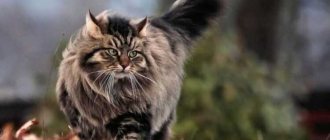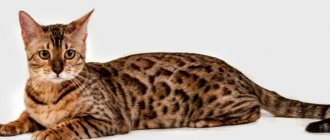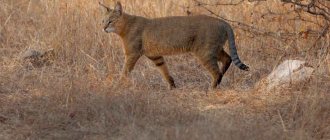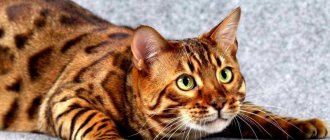Save the article:
If you are not familiar with the Nile cat - the same one that the Egyptians began to domesticate in ancient times, then it’s time to learn about it. Although the very first drawings and legends about such a predatory and graceful animal date back to Ancient Egypt, the jungle cat inhabited quite vast territories in different countries.
Why are we talking about such a magnificent animal as the reed or swamp lynx in the past tense, if it is an amazing hunter? It is precisely this quality that was not appreciated by those people whose jungle cat actively exterminated poultry. The durable and beautiful skin of the animal found its application in the economy - the process of extermination of the wonderful creature was launched, anthropogenic activity in nature also made its contribution. But did these colorful individuals remain in their natural habitat? It's time to learn about the jungle cat, also called the house cat (from the Latin Felis chaus), and its fate in our time.
Description and origin of the species
The first scientist to catch and describe the jungle cat was the German zoologist Johann Güldenstadt. While on an expedition by order of Catherine II, in 1776 he caught an unusual wild cat on the Terek River, and named it “house”. In 1778, another German zoologist, Johann von Schreber, compiled a scientific description of the new species and gave it the scientific name chaus
). In the 1930s, British zoologist Reginald Innes Pawcock assigned the animal to the genus Felis.
The animal’s closest relatives are other representatives of the Cat genus:
- black-footed cat
- sand cat
- Central European forest cat
- steppe cat
- domestic cat
- Chinese mountain cat
- African wild cat
Appearance Features
Pets of this species have a dangerous temperament, and felinologists even warn against possible difficulties. But first, let's give a description of the jungle cat breed.
Weight reaches 12-15 kg. The cats are large at the withers, up to half a meter. The tail is relatively short, very thin, no more than 35 cm long. The head is not very large, rounded. The ears are large and have tufts inside.
The eyes are almond-shaped, regular in shape. The claws are very massive and sharp. The color is varied, from gray to dark brown with shades of red.
The pattern is interesting: blurry spots, stripes. The fur is quite thick and dense.
In the photo, jungle cats seem docile and very peaceful, but these beauties can literally turn a house upside down.
What does a jungle cat look like? Dimensions and weight
The jungle cat is a graceful, long-legged, medium-sized cat. This is the largest representative of the Cat genus that has survived to this day. House cats are noticeably larger in size than domestic cats and have a more refined build.
The length of the animal’s body including the head ranges from 59 to 76 cm. The height of the predator at the withers is approximately 36 cm, weight varies from 2 to 16 kg. The cat's size decreases from west to east, and similarly from north to south. Thus, the smallest Hausas live in Southeast Asia. The difference in size depending on habitat is explained by higher competition among cats in the southeast. Females are usually smaller in size than males.
The cat has a long and narrow muzzle, with white fur near the mouth. The long ears, 4.5 to 8 cm high, are set close together and have small tufts of dark hair at the tips of the ears. The eyes are yellow, with a narrow long pupil, like those of domestic cats.
The tail, 21 to 36 cm long, is marked with 2-3 black rings towards the end and a black tip. The legs are long: in one step the predator covers an average of 29-32 cm. Due to the long legs, tufts on the ears and the relatively short tail, the house looks like a small lynx.
The color of the cat is uniform, without spots, the color of the fur varies from sandy and light yellow to red-brown and gray shades. Black and white jungle cats, that is, albino and melanistic animals, are found mainly in India. In terms of fur color, jungle cats resemble caracals and African wild cats.
Kittens are often born spotted and striped; the pattern may be partially preserved into adulthood. There are 4-5 dark rings on the back of the front legs; they are hardly noticeable from the front. The fur on the belly is usually noticeably lighter than the color on the back and sides; the fur on the throat is quite light. The fur on the back is noticeably thicker than on the underside of the body. Winter fur is noticeably thicker and denser than summer fur.
Description of the animal
You can recognize such a jungle cat literally at first sight. The animal has a characteristic almond-shaped eye shape and large erect ears. There is a breed standard that allows you to identify such a pet with maximum accuracy:
- The muzzle is elongated.
- The head is massive.
- The eyes are green or yellow.
- The ears are large in adults and have a tuft.
- There are deceptive eyes on the back of the ears.
- Jungle cats have a short, thin tail that makes up about one-third of their total body length.
- The body is powerful, with a wide chest.
- The paws are long.
- The coat is short, smooth and very thick.
- The main colors are silver, black and ticked tabby.
The jungle cat has pronounced sexual dimorphism . Males are always larger than females and at the withers can reach half a meter in height and 120 centimeters in length. An adult jungle cat weighs about 14 kilograms, and cats are no more than ten.
Where does the jungle cat live?
In the wild, the jungle cat lives in the Middle East, Central and Southeast Asia, the Indian subcontinent, Sri Lanka and southern China.
The jungle cat is versatile and is able to live in almost any place where it is not very cold in winter, there is enough water and dense vegetation. The animal lives in swamps, wetlands (wet lands), riverbanks and coastal areas, bushland and grasslands. The predator feels quite comfortable on agricultural lands, such as bean fields and sugar cane thickets, and often settles near people.
House is able to live in areas even with sparse vegetation, although it prefers tall, dense thickets of grass or reeds as a habitat. That is why the animal is called a marsh or reed cat. The predator does not tolerate cold weather well, and rarely lives where snow falls. The animal also avoids tropical forests and sparse forests far from bodies of water, preferring to settle closer to the water.
In India, the House is the most common wild cat. In Iran, it is found on the plains and in the mountains at altitudes of up to 4,000 meters, and lives in 23 of the country’s 31 provinces. In Nepal it rises to an altitude of up to 3,300 meters above sea level; in the Himalayas, a wild cat has been spotted at an altitude of up to 2,300 meters.
In Russia, the Caucasian jungle cat lives along the northwestern coast of the Caspian Sea. In the wild, the animal can be found in the Republic of Dagestan, Ingushetia, Kalmykia, Chechnya, North Ossetia and the Astrakhan region. In the Stavropol Territory, the population is unstable, and rather consists of animals wandering from other regions. The jungle cat has not been seen in the Volga delta since the 1980s, so the population of predators in the Astrakhan region has been practically exterminated.
Interesting Facts
- The jungle cat often bathes and likes to dive headlong. The animal does this to eliminate the unpleasant odor of its body, as it scares away potential victims during the hunt.
- The animal hunts at night. It first watches the prey, then quickly jumps towards it, grabs it and bites it.
- A representative of the feline can watch the victim for hours, sitting near his hole.
- Males are born much more often, their share in the brood is approximately 76%.
- The animal's fur is coarse and short. In the summer the cat sheds, and in the winter it is covered with thick fur.
- In captivity, males raise their cubs and take care of them.
- The jungle cat's pupils are elongated into vertical lines.
Character and lifestyle
House is diurnal and hunts during the day. In the midday heat, the cat rests in thickets of bushes, reeds or burrows. In winter he likes to sunbathe. It can also hunt at night, although this depends on the amount of prey available, and they walk 3-6 km in search of prey.
Houses lead a solitary lifestyle, and outside the mating season they do not communicate with their relatives. The only exception is females with growing cubs. Each animal has its own territory, which they mark with scent marks, urine and rubbing their muzzle on various objects. When faced with a rival for prey, a female or territory, the jungle cat emits a loud warning growl and tries to scare the enemy - this behavior is not typical for other cats.
The animal's favorite method of hunting is a sudden ambush attack on the prey, followed by a short sprint or several jumps. The predator usually searches for prey by ear, guards the burrows of water rats and actively searches for bird nests. House is not very fast - the predator can reach speeds of up to 32 km/h, so it rarely pursues prey if it has managed to escape. Like the caracal, the jungle cat is capable of jumping high to catch birds in the air. House climbs trees well and is an excellent swimmer - this wild cat can catch fish by diving headlong after it, and will swim across a river up to 1.5 km wide.
Organizing cat care
Home care includes hygiene control, walks in the fresh air, and grooming. In practical terms, caring for a pet is not difficult, especially if you manage to get along with the cat.
It is not advisable to keep a jungle cat in an apartment due to the lack of free space. The best option is a private house with a wide yard. Walking in the fresh air is strictly necessary for representatives of this breed to maintain normal levels of vitamin D and optimal metabolism of calcium and phosphorus.
Hygienic care includes the following measures:
- The jungle cat is a very clean breed. It is necessary to comb the fur only during the molting period. A special brush is used for this purpose. Maximum attention is paid to the combing procedure so as not to cause pain or discomfort to the pet. To do this, you can alternate between combing and brushing different areas of the body (mainly the space between the ears, head and back). You can try to perform the manipulation while the cat is sleeping. The resulting coarse clumps of hair are carefully cut off without trying to untangle them with your fingers.
- Washing paws after walks helps keep the spaces between the toes and the skin on the paws clean. For this purpose, you should purchase gel or liquid soap with surfactants (designed specifically for cats).
- Bathing should be carried out approximately once a week (this factor depends on the conditions of detention and the individual characteristics of the pet).
To prevent ticks and fleas, tablets, drops, and powder formulations should be used. Regular treatment of your pet for helminths is also important, especially when living in a private home.
A mandatory accessory for a predator is a nail sharpener. It is important to firmly fix the structure.
This can be a production model, or a homemade one: A pipe with ropes, a log.
What does the jungle cat eat?
Like other predators, the Haus eats mainly meat. Prefers mainly small mammals for food:
- rodents, particularly mice and Mongolian gerbils
- hares
- birds, mainly waterfowl (ducks, coots, partridges, pheasants)
- nutria, muskrats, water rats
- fish, mostly carp
- gophers
- wild boars (piglets)
- frogs
- small snakes and lizards
- insects
- small gazelles
Rodents make up at least 95% of the animal's diet. For the most part, the prey consists of small animals weighing up to 1 kg; occasionally the house hunts larger prey, for example, small antelopes. Unlike many other wild cats, Hausas are partially omnivorous and often eat fruit, especially in winter. Near residential villages, cats often carry livestock - chickens, ducks, geese, rabbits. It also does not disdain fresh carrion.
Reproduction and young
Males and females reach sexual maturity at about 1 year of age. Estrus in females lasts about 5 days. The peak mating season usually occurs in winter, from January to March. During the mating season, loud fights often occur between males over the right to mate with a female. During mating, House cats behave in the same way as domestic cats - the male pursues a female in heat and mates with her, holding her by the scruff of the neck. After successful completion of the process, the female drives the partner away with loud screams, and the couple separates.
Pregnancy lasts almost 2 months. Females prepare a shelter in advance - they line an old hollow, an abandoned den or a secluded place in a reed thicket with grass. Cats typically give birth between December and June, although the timing may vary depending on where the animals live. In one litter, from 1 to 5 kittens are born, with an average of 2-3 cubs. Newborn kittens weigh only 45 to 55 grams, are blind and helpless. The cubs' eyes open from 10 to 13 days, and the mother feeds them milk for up to 3 months.
Kittens begin to hunt independently at the age of 6 months. At 8-9 months they finally leave their mother and go into independent life. In the wild, males do not participate in raising the young, but in captivity they actively protect their offspring.
Origin of the breed
Jungle cat or marsh lynx are synonymous names for wild cats. This is a fairly large animal, ranging from 60 to 90 cm in length and weighing from 8 to 12 kg. If you look from the side, you will find that the cat has a short body with long legs. These proportions are necessary for hunting birds in high reeds. The cat's tail is short - from 21 to 30 cm. The color is spotted black-brown or solid brown. There are tassels on the ears.
The species was discovered by traveler Johann Anton Güldenstedt in 1776, when, on the orders of Catherine the Great, he mapped the southern territories of the Russian Empire. Two years later, Johann Christian Schreber included the animal in official documents, gave it its current name and described its appearance in detail.
Important! Jungle cat is the name of a wild breed. It is more correct to call pets a houseie or a chausie.
Quite widely distributed. Found in Western and Minor Asia, Transcaucasia, Central Asia, Hindustan, Indochina and Southwestern China. On Russian territory it can be found on the plains of Dagestan and on the shores of the Caspian Sea and in the lower reaches of the Volga. However, due to hunting and poaching, the jungle cat is now becoming less and less common. The last time it was seen in the wild in Russia was in 1985, back under Soviet rule.
Important! The jungle cat is in the Red Book of Russia. Hunting is prohibited.
Swamp lynxes love to settle in dense reed and reed thickets near rivers, swamps, lakes and seas. These animals are excellent swimmers. Cats rarely go out into open spaces, but sometimes they can be found near their habitats. In the mountains, cats were found at altitudes of no more than 800 meters. More often, the jungle cat leaves its usual habitats in winter and spring, during periods of food shortage.
The mating period begins in February and ends in March. At this time, cats can be heard over long distances due to their loud cry. During this period, males can pose a threat to people, as they are large enough to kill or severely injure an unarmed person. Females carry their cubs for 66 days. In May, from 2 to 5 kittens are born. They become sexually mature after 1.5 years.
Important! It was when the swamp lynx was crossed with Abyssinian cats that a new breed appeared - the Hausie.
A new type of domestic cat was first obtained in 1960 and registered in 1995. The breed has the appearance and strength of a wild ancestor, but at the same time it is docile and able to get along with people, although it has a wayward character. Cats have a large body and ears with tassels. They are very strong, capable of jumping high and hunting. But at the same time, they have a friendly character and love to communicate with people.
Exterior
Houses got their exterior from jungle cats:
- The coat is short . In summer the coat is loose and coarse, in winter it becomes dense and dense.
- The color is black, brown , sometimes slightly silver, usually tecked. Often pets turn out to be multi-colored with brown and black stripes or spots. The coloring greatly depends on what subspecies of the jungle cat is the pet’s ancestor. In southern Asian regions they are brownish-red in color, while in Central Asia and Africa animals with a dirty yellow tint predominate.
- Body . These pets are very large, males weigh up to 15 kg, females - up to 10 kg. The height at the withers is about half a meter. They live long - up to 15 years.
- Head . An important feature is the tufts on the ears, which is why the pets resemble a lynx. Has excellent hearing and night vision. The sense of smell is poorly developed.
- Other characteristics . The tail is of medium length, rather thick. The paws are high, with well-developed muscles, very strong.
Character
Behavior, activity and attitude towards people are very different between wild and domestic representatives of the breed.
Wild swamp lynx
In nature, jungle cats are loners who will not tolerate the presence of other representatives of their species. They are wary of people, hiding in high reed thickets. In February-March, they begin to estrus; males and females begin to look for a mate. All this happens with shouting and fighting. Next comes several months of “married” life. After 2 months, the female gives birth to several kittens.
Kittens feed on their mother's milk for up to 3 months. And at 2 months they begin to learn to hunt, so far only in the form of play. By 5 months they are still immature and do not have the size of an adult animal, but are already large and strong enough to leave the parental home. At this time, the family breaks up, and the kittens begin an independent life.
Domestic jungle cat
Domesticated jungle cats, or bred house cats, have a good-natured but capricious character. They are very active and require a lot of space, so they must be allowed outside or even walked with them on a leash. Cats are quite silent, they can only snort and hiss, but if necessary, the pet is able to express its needs with a loud, powerful bass voice.
Cats are quite calm and do not fight with other pets or even dogs. They are very devoted to their owner and need affection and communication with him. However, their patience is sometimes lacking; pets are capable of attacking a person or animal that annoys them. These cats are quite smart and potty train quickly. During the period of sexual hunting they become aggressive and even dangerous.
Important! It is imperative to spend time with the kitten, otherwise it may go wild.
To summarize, home houses have the following character traits:
- Mobility . Cats love to explore the world around them, they are mobile and active. You need to walk with them. Pets quickly learn to hunt and can catch not only mice, but also birds and other small animals.
- Learns quickly . He can be taught to go potty, open and close doors. But at the same time they can be capricious, so although they can be trained, they sometimes show their temper.
- They are sociable , but do not like to be held. Cats are never against playing with members of the household; they often follow their owner, demanding communication and affection.
- Good nature . Despite their wild features and love of hunting, the pets are quite friendly. They often build warm relationships with children and other animals, including dogs. There are even cases where cats lived together with mice and poultry.
- Love for water . They are great at water procedures. At the same time, they swim well and always accompany their owner while swimming in the river.
- Demanding on space . They love to go for walks and need it. The radius of their “personal” territory is 100-200 meters, but they can go further for the purposes of hunting, walking or searching for a partner.
- They are hunting . In urban areas, cats can hunt birds, in rural areas - rats, mice, otters and other small animals. Other cats or small dogs are not usually attacked.
Kittens can be purchased after 3 months, when they stop drinking mother's milk and have completed all childhood vaccinations. However, many recommend buying them at 5 months, then you can not make a mistake with the gender, as well as with the color of the pet. In addition, by this time they should already be accustomed to the potty, scratching post and their place. In addition, kittens can learn hunting and social skills from their mother.
Maintenance and care
These pets are not particularly picky, but some care is needed.
Walks
It is preferable to keep a pet in a country house. In urban environments, he needs to be walked periodically. Of course, this is not a dog, so there is no need to take him out 2 times a day. But it is necessary to walk your Hausa 2-3 times a week. Otherwise, health problems may occur due to lack of mobility and ultraviolet radiation. In particular, cats quickly gain weight and develop problems with their skin and fur.
Combing
It is necessary to comb the fur only during the molting period. The rest of the time, no special care is required. When kept at home, shedding may be delayed. You need to comb your pet with a furminator. When kept at home, you need to wash it as needed; in rural areas, you can clean the cat once a week and treat it for fleas once a month.
In cases where a jungle cat does not allow itself to be combed, you need to use the following tips:
- Brushing a cat's head, back, and between the ears is always a pleasure. Alternate brushing these areas with other areas.
- Try doing this while your cat is sleeping.
- The procedure must be carried out carefully so that the pet does not feel pain.
- If you are worried, combing can be postponed for an hour or two.
- The tangles must be cut out in advance, the strands should be sorted out with your fingers or cut off.
- Before brushing, take your pet for a walk and then feed it. Then the cat will be soft and lazy.
Nail care
You need to equip a scratching post for your cat.
It must meet the following requirements:
- It is sufficiently firmly attached, since the cat will not only sharpen its claws, but also try to play with the device. It is better to fix it with a cross.
- The best option is a log. But a plastic pipe wrapped in ropes will also work.
- The scratching post must not be coated with varnish or other dyes.
- It is advisable to make several scratching posts, but at the same time, so that they have a different texture.
You can train it by lubricating the scratching post with catnip.
The claws should be trimmed according to this pattern:
- Make sure your cat is comfortable.
- Hold his paws firmly.
- Hold the nippers in your right palm, and with your left, press on the pad in the middle so that the claws come out.
- Look at them from the side. Usually the claws are translucent, which is why you can see the pink area - the vascular zone.
- Trim the tip, leaving at least 2 mm from the pink area. The nippers must be strictly perpendicular to the plane of the claw.
- Sharpen the sharp cut edges of the claws with a file.
- If the vessel is damaged, treat the wound with an antiseptic.
The claws can be ground down every few months. To do this, use a nail file, nippers or small scissors. Cotton wool moistened with hydrogen peroxide must be used to treat the claws before and after grinding.
Bathing
House has a positive attitude towards bathing. The procedure can be carried out as the coat becomes dirty or before an exhibition. The water temperature should be optimal – +38…+40oC. You can put cotton wool in your ears to prevent water from getting in there. You need to fill a small basin or bath with water and put a mat on the bottom so that the animal’s feet do not slip. Wet the fur, soap the pet, rinse off the foam. After water treatments, you need to dry your hair with a hairdryer. Finally, the cat should be kept warm for the next 3-4 hours.
Health
Due to crossbreeding with wild animals, Hausas have excellent health. Cats, like all members of the feline family, are predisposed to ICD. However, due to their active lifestyle and large body size, this disease is observed in them much less frequently than in other males of the same species of animals. The typical life expectancy for the cat family is about 15 years.
Cats need to have their vaccinations up to date. Kittens at 3 months are vaccinated against herpesvirus infection, panleukopenia, and calicivirus. Adult animals are vaccinated annually. But before this, deworming must be carried out. Pets are also given anthelmintic drugs every six months for preventive purposes.
Subspecies of the jungle cat
In 2005, the taxonomic reference book Mammal Species of the World recognized 10 subspecies of Hausa. As of 2021, the IUCN Felid Specialist Group recognizes only 3 subspecies.
- F.c.
chaus . Caucasian and Central Asian jungle cat. It lives in the Caucasus, Turkmenistan, Pakistan, Syria, Iraq, Iran, Egypt, Turkey, Tajikistan, and Afghanistan. - F.c.
affinis . Habitat: South Asia. Lives in India, Bangladesh, Sri Lanka, Nepal. - F.c.
fulvidina . Habitat: Southeast Asia: Vietnam, Myanmar, Thailand, Laos, Cambodia.
Natural enemies and threats
In the wild, Hausas are hunted mainly by bears, common jackals, leopards, crocodiles and large snakes. In addition, the cat has to compete for prey with other predators - foxes, the same jackals, forest cats and birds of prey, for example, marsh harrier.
The main threat to the Hausa is humans.
- The animal's habitat is rapidly declining due to the draining of swamps, the construction of dams, the development of agricultural land and urbanization.
- In Turkey and Iran, the animal is actively hunted by poachers. Illegal trade in skins continues in India, Egypt and Afghanistan.
- In Southeast Asia, the number of individuals has decreased significantly in recent years due to active hunting of the animal by hunters for the sake of its skin and for souvenirs. Hausas are hunted most often in Laos, Cambodia and Vietnam.
- In Jordan, Syria and Palestine, the Hausa population suffered serious losses due to the expansion of agricultural areas along the Jordan River and its tributary Yarmouk. Farmers in these regions shoot and poison cats en masse for attacks on poultry.
Population and conservation of the species
There are only about 500 wild hausas left in Russia.
The jungle cat is listed as a species of Least Concern by the IUCN Red List and on Appendix II of CITES (restricting international trade in animals). In Russia, the reed cat is also listed in the Red Book of the Russian Federation as a rare, endangered species.
Hunting the animal is prohibited in Bangladesh, China, India, Israel, Pakistan, Myanmar, Tajikistan, Thailand and Turkey. Outside the reserves, the animal is not protected from hunters in any way in Bhutan, Georgia, Laos, Libya, Nepal, Cambodia, Sri Lanka and Vietnam. In Russia, hunting Hausa is allowed only in exceptional cases, with a special permit (license).
Feeding
In nature, Hausas do not eat porridge. Therefore, you should not offer them a cereal menu at home. But live food, no matter how humane it may be, will have to be fed to the jungle cat every day. After all, what does a jungle cat ideally eat? That's right, game.
The traditional daily diet of an ex-savage looks like this: 200 grams of lean meat plus a couple of live mice (or one rat). As an alternative, high quality Orijen cat food (link to the official website).
Jungle cat at home
A purebred wild reed cat is difficult to tame. Having one at home would not be the best idea. Firstly, it will be difficult to buy a purebred wild house kitten, and besides, you may be very unlucky with its character. Purebred houses can be wild, they often run wild with their owners, destroy apartments and refuse to eat from their hands and do not cuddle like ordinary domestic cats.
For those who still want to have a domestic jungle cat, there is an excellent solution - the Chausie. The Chausie, or Hausie, is a new breed of cat, a cross between the jungle cat and the Abyssinian cat. The kittens inherit the unusual appearance and unique exterior of a swamp lynx from their purebred Hauss father, and their affectionate and flexible character from their Abyssinian mother.
Chausies are similar in character to ordinary domestic cats; they are affectionate, energetic animals that love to walk, swim and become strongly attached to their owners. At the same time, they inherit the unusual appearance of the swamp lynx - a muscular body, long limbs, ears with black tassels, gray color. Chausies are larger in size than Maine Coons and live up to 20 years. It is quite possible to buy a kitten of the 1st-3rd generation (F1-F3) for 100 - 300 thousand rubles, the price depends on the generation, pedigree and breeder.
Health
Such a cat has excellent health and immunity, since its genes were selected by nature itself. They are completely free of any hereditary diseases that are typical for artificially bred, “refined” cat breeds.
There are no special problems when keeping an animal. But he needs ultraviolet light, and therefore it is recommended to walk such pets outside on a harness, as well as a balanced diet. The jungle cat requires the attention and affection of the owner and games.
If these simple rules are followed, the animal will delight its owners with many years of life. Typically, the life expectancy of a jungle cat is 13-18 years. Also read the article about how long cats live.











